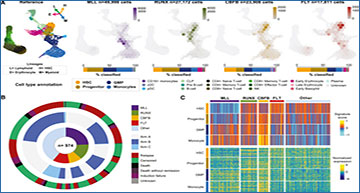Pediatric acute myeloid leukemia (pAML) is characterized by heterogeneous cellular composition, driver alterations and prognosis. Characterization of this heterogeneity and how it affects treatment response remains understudied in pediatric patients. Researchers at the Michael Smith Genome Sciences Centre used single-cell RNA sequencing and single-cell ATAC sequencing to profile 28 patients representing different pAML subtypes at diagnosis, remission and relapse. At diagnosis, cellular composition differed between genetic subgroups. Upon relapse, cellular hierarchies transitioned toward a more primitive state regardless of subtype. Primitive cells in the relapsed tumor were distinct compared to cells at diagnosis, with under-representation of myeloid transcriptional programs and over-representation of other lineage programs. In some patients, this was accompanied by the appearance of a B-lymphoid-like hierarchy. These data thus reveal the emergence of apparent subtype-specific plasticity upon treatment and inform on potentially targetable processes.
Lambo S, Trinh DL, Ries RE et al. (2023) A longitudinal single-cell atlas of treatment response in pediatric AML. Cancer Cell [Epub ahead of print]. [article]





